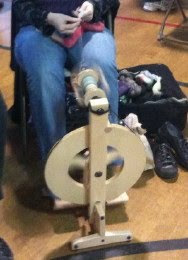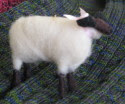 When I went tramping through the fields to the fiber festivals this fall, I had a pretty scrumptious new sweater to wear. It's the Fireside sweater pattern by Amber Allison.
When I went tramping through the fields to the fiber festivals this fall, I had a pretty scrumptious new sweater to wear. It's the Fireside sweater pattern by Amber Allison.There's a bit of a story behind this pattern. There was a cute little romantic comedy movie in 2006 called The Holiday. It starred Cameron Diaz and Kate Winslett, as two strangers in the US and UK who, each unhappy and needing a change, swap houses for a brief vacation. The movie was lightweight and pleasant, but a buzz developed about the wardrobe worn by Cameron Diaz. One sweater in particular, extravagantly cabled and trim, really caught the eye. (It's the fourth one down the page on the preceding link.) Knitters ogled it, sighed over it, and tracked down the impossibly expensive source.
Amber Allison did more than sigh. She was so determined to have this sweater that she (dare I say obsessively?) studied pictures from the movie and recreated it as nearly as she could, stitch by stitch. She also, to the gratitude of legions of knitters, wrote out the pattern and adapted it for a range of sizes. It's remarkable, considering she'd never written a pattern before. On the other hand, I've never read a pattern written quite like this, either. There were a few directions like, "I suggest doing it this way, but I'm not going to tell you how to live your life." Quirky.
I stumbled across the Fireside sweater through Chesley Flotten's Knitting Experience Cafe blog (named after her much-loved but now-closed knitting shop in Maine). Chesley, who has an immaculate eye for great sweaters and a welcoming heart, had picked out the Fireside and was preparing to hold a knit-along for her band of loyal knitters. I, despite living in Virginia -- far, far away from Maine -- decided to join in. It was the first time I'd participated in a knit-along, where lots of knitters work on the same pattern at the same time, in a variety of yarns, discuss their progress, and share their results. It was great fun.
 I made some significant adjustments to the pattern. I checked out out a number of finished Fireside sweaters. (You can see some good pictures of one finished Fireside on the Posh Knits blog, here.) For sizing, I noted a few complaints about tight, skinny sleeves. I chose a fairly snug size but decided to make armholes and sleeves according to the next size up. I also used the length measurements of the next size up. Still, I felt the waist decreases and increases looked like they would be kind of abrupt (this may have been partly due to my row gauge), so I made them longer and more gradual.
I made some significant adjustments to the pattern. I checked out out a number of finished Fireside sweaters. (You can see some good pictures of one finished Fireside on the Posh Knits blog, here.) For sizing, I noted a few complaints about tight, skinny sleeves. I chose a fairly snug size but decided to make armholes and sleeves according to the next size up. I also used the length measurements of the next size up. Still, I felt the waist decreases and increases looked like they would be kind of abrupt (this may have been partly due to my row gauge), so I made them longer and more gradual.For construction, I didn't much relish the recommended procedure of knitting the sleeves in the round and then fitting them into the waiting armholes, so I knit them flat and seamed more conventionally. There were also a few rough edges in the details of the pattern, and I changed some small things in the underarms and the back neck shaping to refine it a bit.
But the sweater came together well, and all the adjustments and changes worked out fine. And, let me be clear, I LOVE this sweater! It's a beauty. Warm, cozy, and cabled, but sleek. It looks great tramping around in the open with jeans or dressed up in a tailored outfit with serious earrings. I venture to say you might even get away with it, in this jewel-like color, as a funky companion for a big gathered silk sort of skirt, the kind of styling you might see in Vogue Knitting magazine. I love it from the top of its stand-up cabled collar to the tip of its purposely over-long sleeves.
 And did I mention that it's sexy? From the back, without the bulk of the overlapping off-center fronts, you can see the overall shape, almost like a curvy jacket. And the way the cables swoop in and out with the waist and shoulder shaping.
And did I mention that it's sexy? From the back, without the bulk of the overlapping off-center fronts, you can see the overall shape, almost like a curvy jacket. And the way the cables swoop in and out with the waist and shoulder shaping.It's a really good-looking sweater. When I wear it, I get a ton of compliments, some on the style, and some on the fit. And some, from knitters, impressed with the cabling (which, honestly, is simpler to knit than it looks). You couldn't ask more than that!
Oh, and thank you, Chesley. :)




























